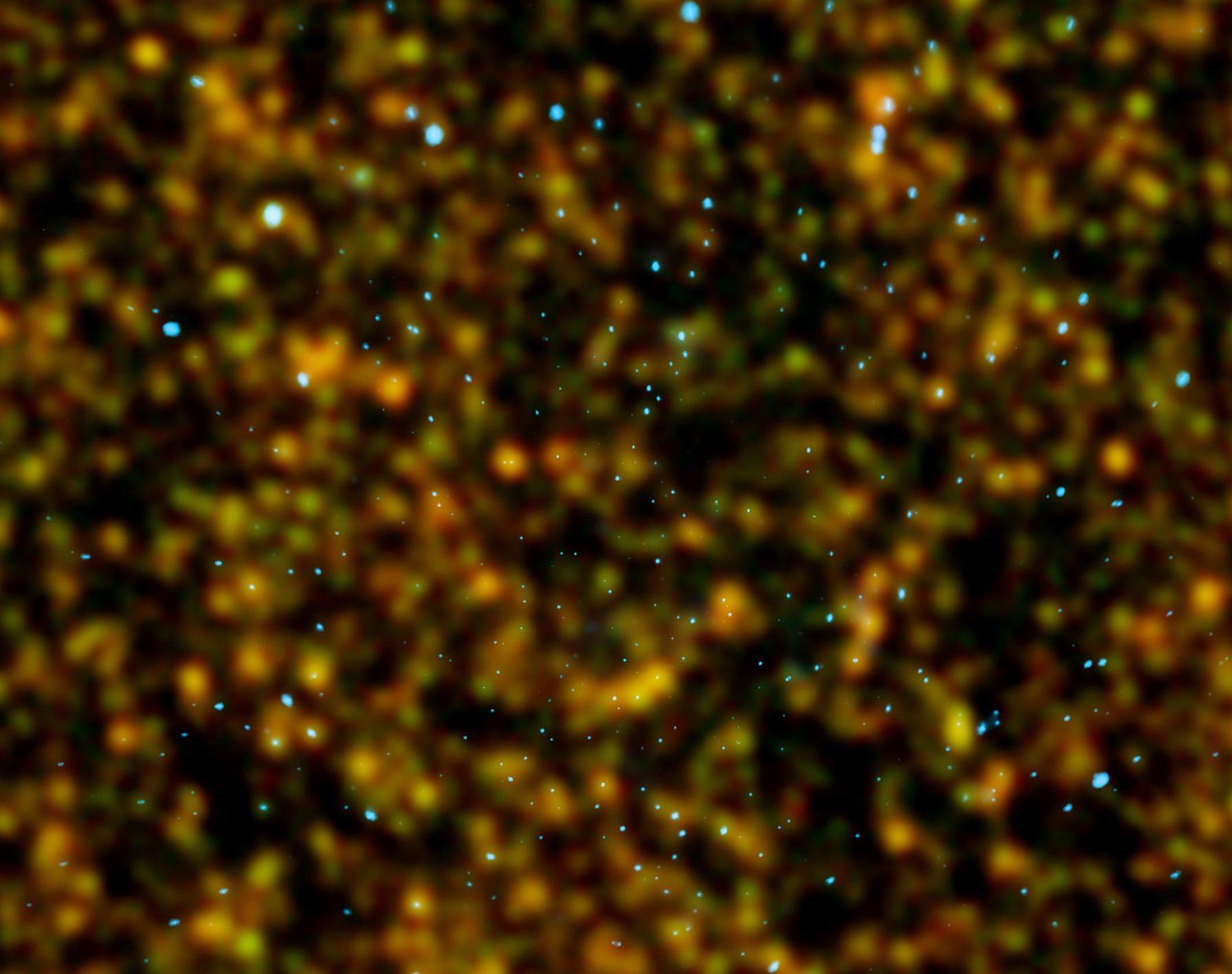| Basic Information | |
| What is this? | A patch of sky containing thousands of distant galaxies |
| Where is it in the sky? | In the constellation of Ursa Major |
| How big is it? | The patch of sky ins less than the area of the Full Moon as seen in the sky |
| How far away is it? | The galaxies are seen as they were between 3 and 10 billion years ago |
| What do the colours represent? | Red and green show far-infrared light emitted by areas of intense star formation; blue shows x-rays radiated by material around massive black holes |
Downloads
See this object in:
Astronomers using Herschel have shown that the number of stars that form during the early lives of galaxies may be influenced by the massive black holes at their hearts. This helps explain the link between the size of the central bulges of galaxies and the mass of their central black holes.
All large galaxies have a massive black hole at their centre, each millions of times the mass of a single star. For over a decade scientists have been puzzled as to why the masses of the black holes are linked to the size of the round central bulges at the hearts of galaxies. The suspicion has long been that the answer lies in the early lives of the galaxies, when the stars in the bulge were forming. To study this phase, astronomers need to look at very distant galaxies, so far away that we see them as they were billions of years ago.
Although the black holes themselves cannot be seen, the material closest to them can get incredibly hot, emitting large amounts of light over a very wide range of wavelengths, from radio waves to x-rays. The light from this super-heated material can be trillions of times as bright as the Sun, with brighter emissions indicating a more massive black hole. There are also strong flows of material (winds and jets) expelled from the region around the black hole.
The hot material near the black hole outshines almost all the light from rest of the host galaxy, except for the light with wavelengths just less than a millimetre. This sub-millimetre light is invisible to normal telescopes but is seen by the Herschel Space Observatory and indicates the rate at which stars are being formed in the galaxy. In the image above, red and green show light from dust in distant galaxies, which is used to measure the rate of star formation. Each one is so distant it is only seen as a single point. The blue spots show x-rays emitted by the incredibly hot material from around the central black holes.

”Herschel provides a new perspective and is conducting a number of surveys of galaxies near and far, in order to unravel the mysteries of the formation and evolution of galaxies across cosmic time,” explains Göran Pilbratt, the ESA Herschel Project Scientist.
The latest study, led by Dr. Mat Page of University College London’s Mullard Space Science Laboratory, used images from the SPIRE camera on board Herschel to calculate the amount of star formation in distant galaxies. This can be compared with the X-rays detected by NASA’s Chandra X-ray satellite, which indicates the growth-rate of the black hole.
“Space telescopes like Herschel let us look back in time, and that’s just what we need to do to find out how today’s galaxies were built. Galaxies were forming stars like crazy when the Universe was young, but trying to see the light from star formation against the glare from the hot stuff around the black hole has been almost impossible until now. That’s all changed with the new wavelengths opened up by Herschel’s SPIRE camera” said Dr Page.
Galaxies with massive black holes were found to have high rates of star formation, with some forming stars at a thousand times the rate of our own Milky Way galaxy today. But intriguingly, the Herschel results show that the fastest-growing black holes are in galaxies with very little star formation – once the radiation coming from close to the black hole exceeds a certain power, it tends to “switch off” star formation in its galaxy.
Prof. Seb Oliver, from the University of Sussex and co-leader of the HerMES project, said “This fantastic result provides an amazing link between black holes and star formation in the early Universe. It is a huge clue to this decade old riddle and could mean that once a black hole is big enough and producing enough radiation, it somehow shuts down the formation of stars in the surrounding galaxy.” The most likely explanation is that the incredibly strong winds from around these very powerful black holes are preventing the gas and dust in the rest of the galaxy from forming stars.
“This means that the total number of stars that form is limited by the power of the black hole that shapes that galaxy” said Dr Myrto Symeonidis, a co-author of the study.
Prof. Matt Griffin of Cardiff University, who is the Principal Investigator of the international team which built the Herschel-SPIRE instrument said “This important discovery shows how the great sensitivity of SPIRE is allowing us to look back in time and understand the early history and development of the galaxies that populate today’s universe. Only a small fraction of the instrument’s observations have been fully analysed so far, and we’re looking forward to many more exciting results.”

